Phonological awareness, Letter knowledge
Children will identify the initial sound of a word. Children also will identify and name the letter E.


New:
Review:
We know that letters make different sounds. Today we are going to learn about the first sound we hear in a word. We will use our names to learn about the first sound in a word. We call the first sound we hear the beginning sound of a word.
Please listen carefully as I say the first sound of a name. We are going to figure out whose name begins with the sound I say. Let’s try the first one.
[Choose the name of a child and enunciate the name’s initial sound only. Example: “Whose name starts with the sound /h/, /h/, /h/, /h/? Yes! It’s Hunter!” Repeat initial sounds of names, such as /d/, /d/, /d/, /d/ David. Where appropriate, stretch out the initial sound in a repeated manner, such as /f-f-f-f/, /f-f-f-f/, /f-f-f-f/ for Felicity.]
Whose name starts with the sound (initial sound of child’s name)?
[If more than one child in your group has a name that begins with the same initial sound, invite children to identify all the children whose name begins with the sound. Tell how many children have names that start with the same sound. Example: “Three children in our classroom have names that start with the sound I am going to say. Let’s try to figure out all three names.”
Continue until children have determined each child’s name.]
Now we are going to learn a different letter of the alphabet.
[Display letter E card.]
Does anyone know the name of this letter?
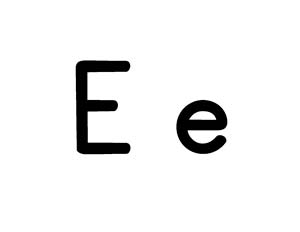 This is the letter E. We can write the letter E in two ways. We can write the letter E like this.
This is the letter E. We can write the letter E in two ways. We can write the letter E like this.
[Demonstrate writing an uppercase E at the top of a chart paper.]
This is an uppercase E.
We can also write the letter E like this.
[Demonstrate writing a lowercase e at the top of a chart paper.]
This is a lowercase e.
We are learning about the importance of exercise. Remember, exercise means we move our body or part of our body for a certain number of times or certain amount of time. We know that we can help keep our muscles strong and healthy by exercising.
The word “exercise” begins with the letter e. I will write this word on our chart. I am going to write the word “exercise” with a lowercase (small letter) e.
[Say each letter as you write the word. Emphasize e.]
Let’s all say the word “exercise.” The word “exercise” has three letter e’s.
[Invite a volunteer child to point to each letter e in the word “exercise.”]
Let’s look at the very first letter of our name. Pop up if you have the letter E at the beginning of your name. Remember, names begin with an uppercase (big) letter.
[Encourage children to look at their name cards. Say the first names of children who have an E at the beginning of their name. If there are children whose name begins with the letter E who do not stand, point to the letter E on their name card. Compare the letter E in their name as you hold the letter E card next to their name card.
If no one in the group has a first name beginning with the letter E, say “No one popped up because no one has a name that starts with the letter E.” Encourage children to look at the list of children’s first names. Point to some first letters of names. Explain that no one’s name begins with the letter E.
If a child indicates there is a letter E in his/her name, but not at the beginning of the name, fully recognize the name and invite the child to pop up. Day 4 gives attention to the letter e that appears somewhere else in a child’s name.]
Today we listened carefully for the first sound of our name. We learned that the first sound is called the beginning sound of a word.
We also learned about the letter E. What is a word that begins with the letter e? (exercise)
Extra support
Enrichment
Invite children to sort *picture cards by beginning sound. Provide two picture cards that begin with each of 3–4 different beginning sounds. Examples: fly, fish, bear, bat, camel, cat, skunk, snake, moose, mouse.
*Printables provided
Practice beginning sounds of animal names. Place *picture cards of animals on a table. Examples: bear, pig, cat, bird, starfish, bee, cow, elephants, alligator, octopus. Invite children to guess which animal you are thinking of by listening to its beginning sound. Example: “I am thinking of an animal that begins with the sound /s-s-s-s/, /s-s-s-s/, /s-s-s-s/.” (starfish) Invite school-age children to spell each animal name and say its ending sound.
*Printables provided
Number knowledge
Children will recognize the numeral 10. Children also will strengthen their understanding of numerals 1–9.


New:

We are learning what numbers 1–9 look like.
[Display large numeral cards 1–9.]
I am going to hold up the cards one at a time. Please say the number on the card and then hold up the same number of fingers. How many fingers should we hold up if I hold up the number two card?
[Display cards 1–9, one at a time, in the correct order. Observe children to see if they have mastered each number displayed. Hold up the correct number of fingers, if necessary.]
Today we will learn what another number looks like. It is the number that comes after nine.
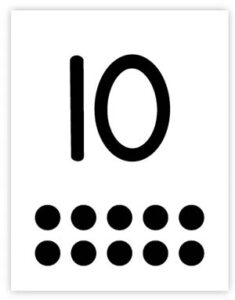 Number 10 looks like this.
Number 10 looks like this.
[Display a large numeral card 10.]
The number ten means there are 10 of something. Let’s count together the dots on the number card.
[Point to each dot on the numeral card as you count. Encourage children to count with you.]
Please hold up 10 fingers. Let’s count them together.
What is something special you notice about the number 10? (it has two numbers)
The number 10 is made up of two numbers.
What are the two numbers in the number 10? (one, zero)
The first number is number one and the second number is zero. Number 10 is different from other numbers we know because it has two numbers!
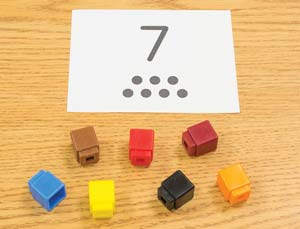 Now let’s work some more with numbers.
Now let’s work some more with numbers.
[Pass out 10 cubes to each child.]
Let’s try it together.
[Hold up a large numeral one.]
What number am I holding up? How many cubes should be in our group? (one) Let’s make a group with one cube.
[Observe children as they make a group with one cube.
Continue holding up large numeral cards 2–10, one at a time, as you invite children to make a group of cubes that represents the same amount. Encourage children to then count together the number of cubes in their group.]
Today we learned what number 10 looks like. What two numbers are in the number 10? (one, zero) We also practiced making groups that were the same amount as the number I held up.
Extra support
Enrichment
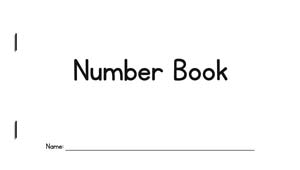 Supply *number books. Put one numeral from 1–10 on each of 10 pages and staple them together to make a book. Invite children to place the corresponding number of stickers on each page. Example: On the page with a numeral five, children will place five stickers.
Supply *number books. Put one numeral from 1–10 on each of 10 pages and staple them together to make a book. Invite children to place the corresponding number of stickers on each page. Example: On the page with a numeral five, children will place five stickers.
*Printables provided
Use *numeral cards throughout the day. Example: “Please show me how many crackers you would like by pointing to the card that shows the number you want.” School-age children may enjoy working with numbers as they play hopscotch and count by 5’s or 10’s.
*Printables provided
Knowledge of creative processes
Children will understand that some musical instruments have strings that make sounds.


New:
We know there are many different kinds of musical instruments. Yesterday we learned that musicians can blow air into some instruments to make a sound.
Let’s hold our hand in front of our mouth and blow air onto our hand. This will help us remember that air can make a sound in an instrument.
Today we will learn that some musical instruments have strings. Musicians use the strings to make a sound.
[Display pictures of a musician playing a double bass and a musician playing a violin. Name each instrument. Children are not expected to remember the name of each instrument.]
The musicians in these pictures are making a sound by moving a bow across a string on the instrument. A bow is a special tool used to play a musical instrument that is made with strings. The bow rubs against a string to make a sound.
[Point to the bow and strings in each picture.]
A musician can also make a sound by pulling a string quickly with a finger.
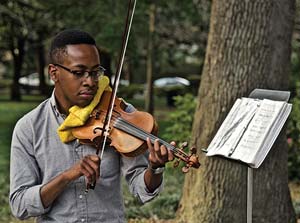
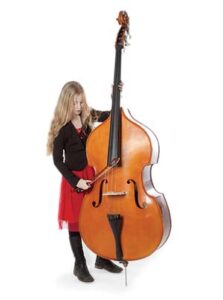
[Display the two pictures side by side.]
What differences do you see between these two instruments? (size, how held by musician)
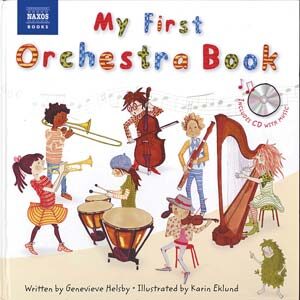 Let’s listen to the sound of a violin. It is the smaller instrument. We can pretend we are playing the violin when we listen to the music made by a violin.
Let’s listen to the sound of a violin. It is the smaller instrument. We can pretend we are playing the violin when we listen to the music made by a violin.
[Display the photo of the violin and play Track seven on the CD included in My First Orchestra Book. Be sure to identify the violin sounds.]
Now let’s listen to the sound of a double bass. It is the bigger instrument. We can pretend we are playing the double bass when we listen to the music made by a double bass.
[Display the photo of the double bass and play part of Track 13 on the CD included in My First Orchestra Book. Be sure to identify the double bass sounds.]
How were the sounds of these two instruments different? (one sounds high, one sounds low)
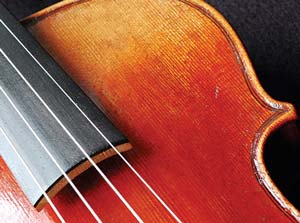
[Display picture of instrument strings.]
Some instruments have four strings and some have six strings. Musicians can control how loud or quiet the sounds are by how hard or softly they touch or rub a string.
Do you think the instrument would sound loud or quiet if a musician rubbed or pulled hard on a string? (loud)
A musician uses his/her fingers to hold down the strings in different places to make different kinds of sounds.
[Point out the musician’s fingers on the strings as you display the picture of the musician playing a violin.]
Today we learned how musicians make music with instruments that have strings. We learned that a musician moves a bow across a string, or quickly pulls on a string, to make a sound. A musician controls the volume of the instrument by how hard or softly he/she rubs the bow on a string or pulls a string.
Extra support
Enrichment
Provide My First Orchestra Book and CD in the listening center. Encourage children to listen to the CD as they look through pages of the book. String instruments are shown on pages 20–29. Invite children to focus on Tracks 4–13 (string instruments).
School-age children may enjoy telling about string instruments they have learned about or seen at school.
Understanding Feelings
Social-Emotional
Skill and Goal
Emotion knowledge
Children will understand what it means to feel loved.
Materials
Needed
*Printables provided
Key
Concepts
New:
Also
Promotes
Optional
Reading
Today we will talk about what it means to feel loved. We feel important and special when we feel loved. Feeling loved makes us feel good inside.
What do we see on the front cover of our book?
[As you read the book, emphasize how much Little Nutbrown Hare loves Big Nutbrown Hare. Use your own words to describe illustrations.]
How did Little Nutbrown Hare show Big Nutbrown Hare how much he loved him? (stretched his arms, jumped up high, stood on his hands, etc.)
People can show their love for each other in many ways. Let’s look at some pictures of people doing things that show their love.
[Display each of the four pictures, one at a time. Encourage children to share their thoughts about how the people in the pictures are showing their love. Examples: “What is the man doing that shows the boy he is loved?” “Why do you think the grandmother is smiling as the boy gives her flowers?”]
There are many ways to show our love for someone. We feel important, special, and really good inside when we feel loved.
Scaffolding Tips
Extra support
Enrichment
Center Activity
Provide the book used during the activity and several stuffed animals. Encourage children to act out the story.
Family Child Care
Provide paper, marker, child-size scissors, glue, and crayons. Encourage children to create something that shows another person how much he/she is loved.